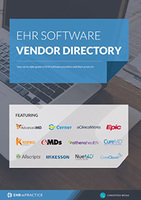EHR interoperability: what to expect in the next five years
Integration of EHR systems has grown across healthcare settings, from hospitals to private practice, to home health and long-term care. However, the integration and utilization of electronic records is only the first step. The real challenge for the healthcare market and EHR vendors in the next coming years, will be continued improvement of EHR interoperability.
Just as society continuously demands more from modern technology, healthcare administrators and clinicians will continue to expect more from the performance of EHR systems. Here is what we can expect in the next five years with regards to EHR interoperability:
Improved ability to send clinical information to any provider
Now that the majority of providers are working with EHR systems, there is an expectation that they can communicate clinical information within specialties. With improved EHR interoperability, clinicians will be able to send information to any other provider nationwide, no matter which system is used. This will streamline care coordination, especially for patients who may be seeking a second opinion.
Recommended reading: find interoperable EHR systems with our completely up-to-date and objective EHR vendor directory.
Increased patient involvement and patient outreach
As EHR interoperability improves, patients will have an increasingly prominent role in their healthcare. Patients will have increased access to their medical information through more comprehensive patient portals. If a patient is due for a screening, the system will be able to reach out to the patient to improve compliance and book an appointment. Recommended screenings, tests, and laboratory measures could be driven by physician set protocols for best practice, and the EHR system could take the lead for getting these procedures scheduled.
Increased use of cloud-based systems
In order to improve interoperability between systems, many vendors will move toward a cloud-based EHR. This type of model is a simple solution to overcome software communication issues. Internal software systems will fade away, as they challenging to modify and communication with other systems is difficult.
More streamlined documentation
As interoperability improves, there will be a more efficient process for documentation. The burden of data entry on the clinician will be reduced, as information that is entered by other staff (operations, nurses etc.) will be carried over to the encounter note. Additionally, patient data may be entered by the patient prior to a physician visit, further decreasing the burden on the clinicians.
Increased community health analysis and tracking
The vast amount of patient and medical data will be used to advance the field of medicine. Providers and clinical researchers will use EHR system information for clinical research. For example, improved interoperability will allow researchers to analyze cancer conditions by specific type, location, treatment and clinical outcomes. By pooling data from a large population (think nationwide), clinical findings can be broadened to the general public. Additionally, unique and effective treatment approaches can be identified.
On a broader level, governmental health systems will increase their ability to survey diseases and conditions, such as infectious diseases and obesity. By having access to a larger data set, scientists and physicians will be able to make faster clinical advancements and improve patient care.
Free white paper

EHR Vendor Directory
Get the most up-to-date directory of EHR software vendors. Find the best software for your practice.

Featured white papers
Related articles
-

EHR interoperability challenges and solutions
Why EHR interoperability is important, and how to improve it
-

How your EHR can help you avoid medical errors
How effective EHR use can help your practice in reducing medical error
-

The pros and cons of a standalone EHR system
No chosen form of health IT will come without some difficulties, but what are the advantages and ...



